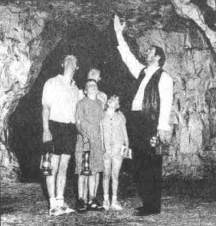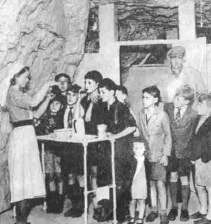
Addiscombe
Home
Heritage
Year 2006 Index
Feedback
Discovering the Kenley and Coulsdon caves

Underground caves in Kenley and Coulsdon became home for thousands of people made homeless by bombing during World War Two.
Valerie Parkin was too young to remember living in caves underneath Kenley during the Second World War. Yet even now when she smells the scent of musty, damp mildew it conjures up feelings of familiarity.
Now she is hoping Heritage readers will be able to help her fill in the blanks about her unusual experience. Valerie says she spent the first two years of her life in the chalk caves, which not only housed hundreds of families made homeless by air raids but also served as bomb shelters.
She is unsure precisely where the caves were but believes they were close to Kenley Aerodrome and thinks around 6,000 people were housed there. While most were forced into the caves by the Blitz, others had become homeless through misfortune, which is how Valerie and her mother came to live there in 1941, the year Valerie was born.
"All I know is what my mother told me," says Valerie. "My mother was a single parent so it was just her and me. She told me there was a damp smell of mildew, yet she somehow had the feeling of breathing clean air because this had been filtered by the chalk. The temperature was the same all year round and we both slept on one narrow bunk, called pitches." Pitches were stacked two or three high up the walls and hollows were chipped out of the chalk for candles.
Valerie added: "The bunks were made of canvas, which sagged in no time and became most uncomfortable. Across the front of a pitch occupants would put up a piece of sacking cloth for some privacy.

"The occupants were very friendly and helped each other. Every section had a marshall who was responsible for the welfare of those under his control. There was also a canteen, washing facilities, a hospital and even a church. "However, for some living in the caves was really depressing."
Cave dwellers had to abide by a list of rules which included:
- No music after 9pm.
- Lights out and absolute silence by 10.30pm.
- Pitches must not be changed, sold or exchanged.
- Four days of absence may result in loss of pitch.
- Breach of rules involves loss of pitch.
Valerie would be left in a creche during the day while her mother worked painting steel bridges. The pair would return to the caves by train each evening. However, when Valerie was two she contracted measles and when she was discharged from hospital a few weeks later their pitch had been taken by another family.
The pair moved to a disused workman's hut where Valerie's mother worked on the railway, providing them with privacy and a steady supply of coal from wagons parked nearby.
Croydon's local studies library holds no information on the caves in Kenley but a report in the London Evening News on August 3,1944, carried a story about cave communities in Kenley and Coulsdon, deep under Riddlesdown Hill, dug out by Surrey County Council. A similar wartime community existed at Chislehurst caves in Kent. At one time, 15,000 people lived underground and it boasted a theatre and hospital, the remains of which are still present.
Valerie visited Chislehurst last year with her husband Malcolm. She adds: "I can't recall much about living in a cave but as soon as the smell hit me I remembered it. "Your sense of smell can be very powerful in terms of linking it with memories."
Valerie's account is featured in The Bourne Society's 46th edition of Local History Records. She would now like to hear from anyone else who lived in the caves.
If you can help, contact Heritage at Croydon Guardian, 10 Pegasus Road, Croydon CRO 4RN or email kmcqueeney@london.newsquest.co.uk. Log on to croydonguardian.co.uk for more Heritage stories.